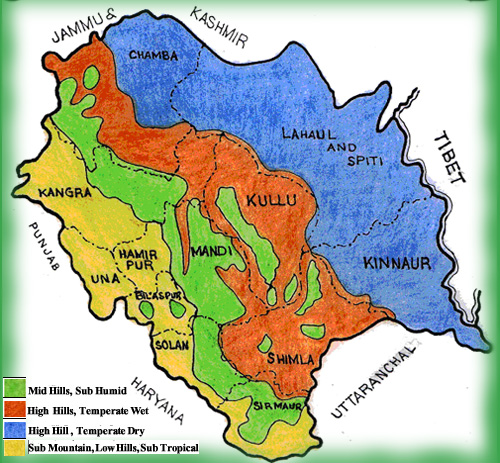Agro Climate Zones of Himachal Pradesh

SHIVALIK HILL ZONE:
- Climate Sub Tropical, consists of foothills and valley area from 350 to 650 meters above mean sea level.
- It occupies about 35% of the geographical area and about 40% of the cultivated area of the State.
- The major crops grown in this Zone are Wheat, Maize, Paddy, Gram, Sugarcane, Mustard, Potato, Vegetables etc.
MID HILL ZONE:
- This zone extends from 651 meters to 1,800 meters above mean sea level.
- It is having mild temperate climate.
- It occupies about 32% of the total geographical area and about 37% of the cultivated area of the State.
- The major crops are Wheat, Maize, Barley, Black Gram, Beans, Paddy etc.
- This zone has very good potential for the cultivation of cash crops like Off-Season Vegetables, Ginger and production of quality seeds of temperate vegetables like Cauliflower and root crops.
HIGH HILL ZONE:
- It lies from 1,801 to 2,200 meters above sea level with humid temperate climate and alpine pastures.
- This zone covers about 35% of the geographical areas and about 21% of the cultivated area of the State.
- The commonly grown crops are Wheat, Barley, Lesser Millets, Pseudo-cereals (Buckwheat and Amaranthus), Maize and Potato etc.
- The area is ideally suited for the production of quality seed Potato and temperate Vegetables.
- This zone possesses good pastures and meadows.
COLD DRY ZONE:
- It Comprises of Lahaul-Spiti and Kinnaur Districts and Pangi Tehsil of Chamba District lying about 2,200 meters above mean sea level.
- It occupies about 8% of the geographical and 2% of the total cultivated area of the State.
- The major crops grown are Wheat,Barley, Pseudo-cereals like Buck wheat and Amaranthus.
- It is ideally suited for the production of quality Seed Potato, temperate and European type of Vegetables and their Seeds, Seed Potato, Peas as green and seed purposes.